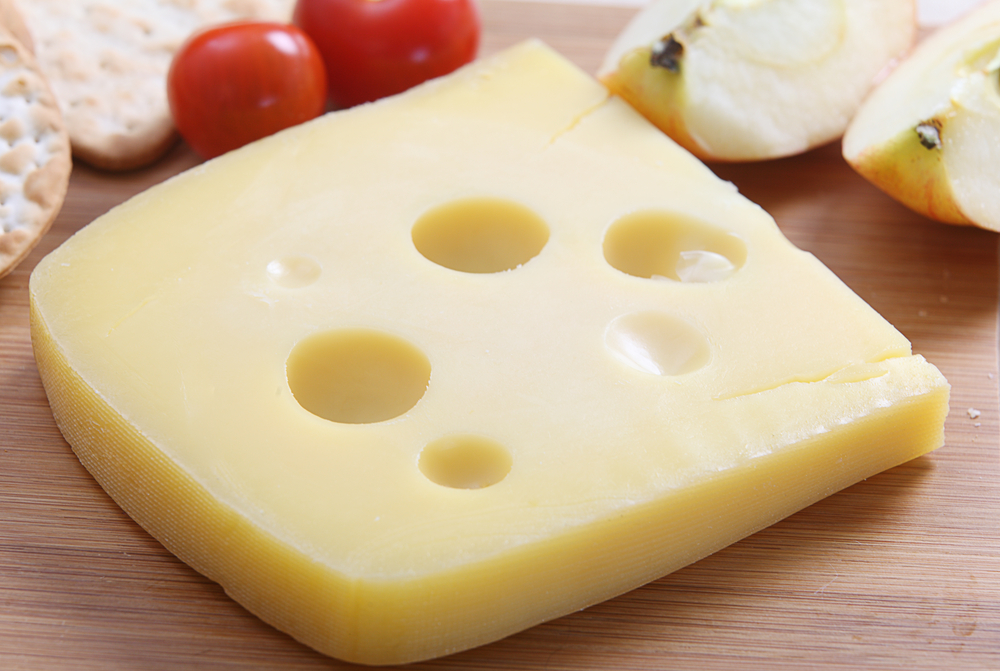Cheese often gets a bad rap for its high calorie count and fat content. But when consumed in small portions, cheese — particularly Jarlsberg cheese — can help preserve bone health.
A small comparative clinical trial, published in BMJ Nutrition Prevention & Health, shows that a small daily portion of Jarlsberg cheese (2 oz) helps ward off bone thinning (osteopenia/osteoporosis) — without raising harmful low-density cholesterol.
The benefits appear to be limited to Jarlsberg cheese from cow’s milk only. Classified as a type of Swiss cheese, Jarlsberg has a nutty, mild flavor with a semi-soft texture. It comes from Jarlsberg Norway, in the eastern part of the country.
Previous research indicates that the Norwegian cheese may help boost levels of osteocalcin, a hormone associated with strong bones and teeth; however, it’s not clear if this effect is specific to Jarlsberg or any type of cheese.
Study Details
To find out, the researchers studied 66 healthy women (average age 33; average BMI of 24) who were randomly allocated to adding either a daily 57 g (2 oz) portion of Jarlsberg or 50 g of Camembert cheese to their diet for six weeks. At the end of this period, the group eating Camembert was switched to Jarlsberg for another six weeks.
Jarlsberg and Camembert have similar fat and protein contents, but unlike Camembert, Jarlsberg is rich in vitamin K2, also known as menaquinone (MK), of which there are several varieties.
The short-chained MK-4 is found in animal products such as liver. The long-chained MK-7, MK-8, MK-9 and MK-9(4H) originate from bacteria, and occur in certain fermented foods, such as cheese. Jarlsberg is particularly rich in both MK-9 and MK-9(4H).
Every six weeks blood samples were taken from all the participants to check for key proteins, osteocalcin, and a peptide (PINP) involved in bone turnover. Vitamin K2 and blood fat levels were also measured.
Blood sample analysis showed that the key biochemical markers of bone turnover, including osteocalcin, and vitamin K2 increased significantly after 6 weeks in the Jarlsberg group.
Among those in the Camembert group, levels of PINP remained unchanged while those of the other biochemical markers fell slightly. But they increased significantly after switching to Jarlsberg. PINP levels also increased.
Blood fats increased slightly in both groups after 6 weeks. But levels of total cholesterol and LDL (harmful) cholesterol fell significantly in the Camembert group after they switched to Jarlsberg.
Glycated haemoglobin (HbA1c) — the amount of glucose stuck in red blood cells — fell significantly (by 3%) in the Jarlsberg group, while it rose sharply (by 2%) in those eating Camembert. But after switching to Jarlsberg HbA1c fell significantly in this group too.
Calcium and magnesium fell significantly in the Jarlsberg group but remained unchanged in the Camembert group. After switching cheese, calcium levels dropped in this group too, possibly reflecting increased uptake of these key minerals in bone formation, say the researchers.
“Daily Jarlsberg cheese consumption has a positive effect on osteocalcin, other [markers of bone turnover], glycated haemoglobin and lipids,” write the researchers, concluding that the effects are specific to this cheese.
The bacteria (Proprionebacterium freudenreichii) in Jarlsberg that produces MK-9-(4H) also produces a substance called DHNA, which, experimental studies suggest, might combat bone thinning and increase bone tissue formation, and possibly explain the increase in osteocalcin, they add.
The research team posits that Jarlsberg cheese might therefore help to prevent osteopenia — the stage before osteoporosis—as well as metabolic diseases, such as diabetes, although further research would be needed to confirm this, they emphasize.
“This study shows that while calcium and vitamin D are known to be extremely important for bone health, there are other key factors at play, such as vitamin K2, which is perhaps not as well known,” comments Professor Sumantra Ray, Executive Director, NNEdPro Global Centre for Nutrition and Health, which co-owns the journal.
The study authors caution that this is a small study, and more research is needed.
Conclusion
“The effect of daily Jarlsberg intake on increased s-os- teocalcin level is not a general cheese effect. Jarlsberg containing vitaminK and DHNA increases tOC,cOC,Ro and PINP and decreases s-Ca , s-Mg and HbA1c. These effects reflect increased bone anabolism and a possible reduced risk of adverse metabolic outcomes.”





